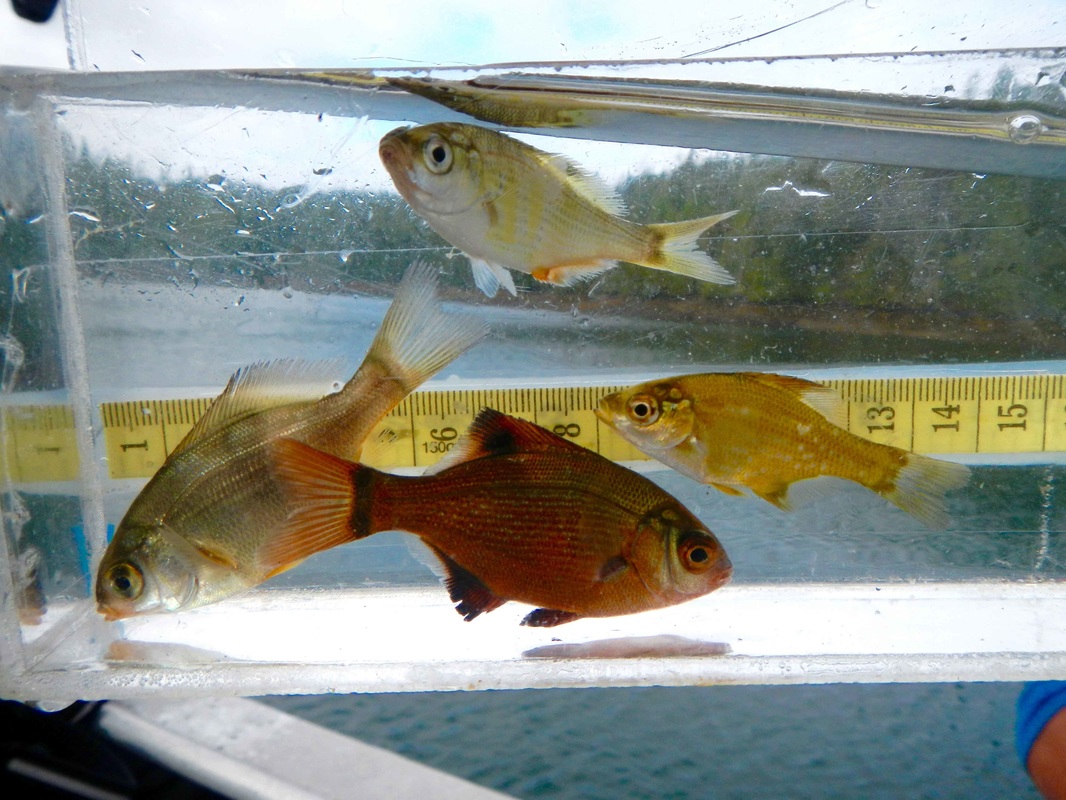Kelp perch, kelp surfperch, brown sea-perch • Brachyistius frenatus
Left: juvenile kelp perch, photographed by the Hakai Intitute FABS (Fish Assemblage Beach Seining) team. Right: a juvenile kelp perch (at right) with a juvenile shiner perch (top), juvenile striped seaperch (bottom), and juvenile pile perch (left). Photo by Kaia Bryce.
Identification
This surfperch can be identified by its brownish colouring and lack of obvious barring or stripes. Its colour varies from olive brown to coppery, and tends to be brighter below the lateral line. Its scales are large, a feature which is emphasized by dark pigment under each scale. Other identifying features include a slightly indented profile between the eyes, a lower jaw that projects out from below the upper jaw, and a deep finless area in front of the tail. Like other surfperches, the kelp perch has a deep body and a forked tail fin. It gets to 22 cm long.
Habitat & Range
The kelp perch is found in the subtidal, usually at depths of less than 30 m though it has been recorded at 76 m. As its name indicates, it is commonly found in the canopies of giant kelp beds (Macrocystis pyrifera) where it is well-camouflaged as it feeds on small crustaceans living on and among the kelp. It may also be found close to the surface of clear water, but does not stray far from the protection offered by kelp. Its range extends from southern Alaska to northern Mexico.
Similar Species
Other surfperches found along the Central Coast have distinct barring (redtail surfperch, shiner perch) or stripes (striped seaperch), or lack the rich brown colouring of the kelp perch (pile perch).
Intriguing Info
The kelp perch may act as a "cleaner fish" by picking and eating external parasites from the bodies of larger fish. In California it is accidentally caught in large numbers by kelp-harvesting machines.
iNaturalist
https://www.inaturalist.org/taxa/117553-Brachyistius-frenatus
This surfperch can be identified by its brownish colouring and lack of obvious barring or stripes. Its colour varies from olive brown to coppery, and tends to be brighter below the lateral line. Its scales are large, a feature which is emphasized by dark pigment under each scale. Other identifying features include a slightly indented profile between the eyes, a lower jaw that projects out from below the upper jaw, and a deep finless area in front of the tail. Like other surfperches, the kelp perch has a deep body and a forked tail fin. It gets to 22 cm long.
Habitat & Range
The kelp perch is found in the subtidal, usually at depths of less than 30 m though it has been recorded at 76 m. As its name indicates, it is commonly found in the canopies of giant kelp beds (Macrocystis pyrifera) where it is well-camouflaged as it feeds on small crustaceans living on and among the kelp. It may also be found close to the surface of clear water, but does not stray far from the protection offered by kelp. Its range extends from southern Alaska to northern Mexico.
Similar Species
Other surfperches found along the Central Coast have distinct barring (redtail surfperch, shiner perch) or stripes (striped seaperch), or lack the rich brown colouring of the kelp perch (pile perch).
Intriguing Info
The kelp perch may act as a "cleaner fish" by picking and eating external parasites from the bodies of larger fish. In California it is accidentally caught in large numbers by kelp-harvesting machines.
iNaturalist
https://www.inaturalist.org/taxa/117553-Brachyistius-frenatus
References
Froese, R. and Luna, S. M. Brachyistius frenatus Gill, 1862 Kelp perch. FishBase. Accessed 17/08/2016.
Lamb, A. and Edgell, P. Coastal Fishes of the Pacific Northwest. Revised. (2010). Madeira Park, BC: Harbour Publishing. Pp. 96-97.
Lamb, A., and Hanby, B. (2005). Marine Life of the Pacific Northwest [electronic version]. Madeira Park, BC: Harbour Publishing.
Authors and editors of page
Kelly Fretwell (2016).
Froese, R. and Luna, S. M. Brachyistius frenatus Gill, 1862 Kelp perch. FishBase. Accessed 17/08/2016.
Lamb, A. and Edgell, P. Coastal Fishes of the Pacific Northwest. Revised. (2010). Madeira Park, BC: Harbour Publishing. Pp. 96-97.
Lamb, A., and Hanby, B. (2005). Marine Life of the Pacific Northwest [electronic version]. Madeira Park, BC: Harbour Publishing.
Authors and editors of page
Kelly Fretwell (2016).






